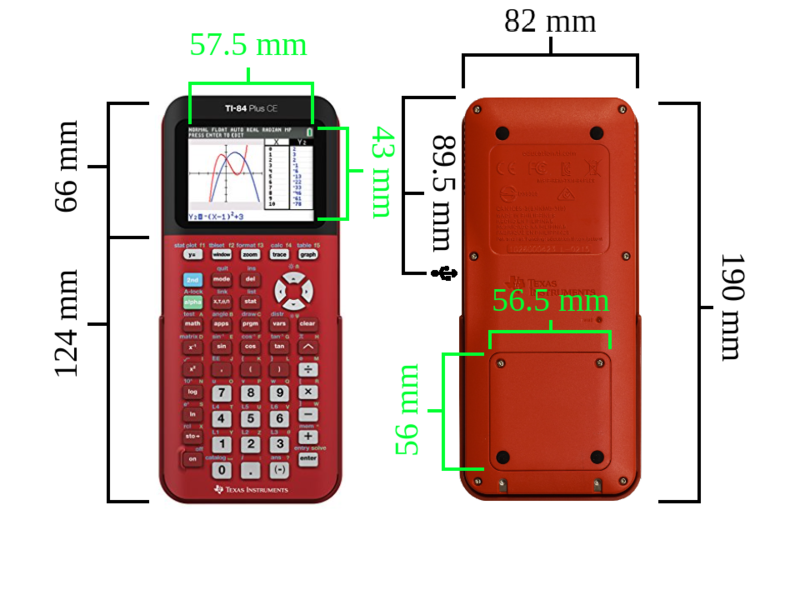Difference between revisions of "Category:84PCE:General Hardware Information"
From WikiTI
(Changed reset length threshold) |
MicahSuess (Talk | contribs) (Fixed Measurements) |
||
| (One intermediate revision by the same user not shown) | |||
| Line 30: | Line 30: | ||
** Holding reset for longer than about 1.5 seconds results in the calculator turning off if it was on; regardless of revision, RAM is cleared. | ** Holding reset for longer than about 1.5 seconds results in the calculator turning off if it was on; regardless of revision, RAM is cleared. | ||
** If charging via USB, a long press behaves exactly like a short press. | ** If charging via USB, a long press behaves exactly like a short press. | ||
| + | *TI-84 Plus CE measurements | ||
| + | [[File:TI84PlusCEMeasurements.png|800px|thumb|left|Measurements of TI-84 Plus CE]] | ||
Latest revision as of 08:41, 4 May 2022
The TI-84 Plus CE and TI-83 Premium are two models new in 2015. The former is for the USA region (maybe all of North American?) and the latter is for France. The hardware is virtually identical between the two models. In 2019, a new revision beginning with revision M was introduced, using a cached serial flash chip and optionally featuring an ARM coprocessor for running Python programs.
Known hardware facts:
- eZ80 CPU
- Physical clock speed believed to be 48 MHz
- CPU performance is severely constrained by wait states for accessing RAM and flash
- On devices manufactured before revision M, the effective clock is speed between 8-16 MHz depending on ratio of RAM to flash accesses
- On later devices, the effective clock speed may be closer to 20 MHz, depending on RAM-to-flash access ratio as well as cache utilization
- 4 MB flash chip
- Bottom-boot organization this time
- 256 K main RAM
- Memory-mapped LCD
- French version (TI-83 Premium CE), and other european versions (TI-84 Plus CE-T), have an LED on top for exams
- User programs are prohibited from using any IN/OUT instructions
- OUT causes a reset
- IN produces a constant value
- There is memory-mapped I/O, starting at E00000. Most port ranges have a mapped address, and RAM programs are allowed to use the memory-mapped I/O.
- The 00xx range of ports is not mapped. This range includes permissions control, flash control, the testing LED, NMI control, and possibly master power management.
- Flash starts at $000000
- There is also still a flash unlock sequence
- RAM starts at $D00000
- Assembly programs and TI-BASIC programs are limited to one sector (64KB)
- VRAM starts at $D40000
- VRAM is executable
- USB IP is the Faraday FOTG210
- The reset button on the back resets the CPU, but may not always reset RAM
- Briefly pressing reset (for shorter than about 1.5 seconds) results in the calculator turning on if it was off. On revisions before M, the boot code always clears RAM, while on revision M or later, the boot code does not clear RAM, but the OS might under some circumstances. This is the same behavior as RST 00.
- Holding reset for longer than about 1.5 seconds results in the calculator turning off if it was on; regardless of revision, RAM is cleared.
- If charging via USB, a long press behaves exactly like a short press.
- TI-84 Plus CE measurements
Pages in category "84PCE:General Hardware Information"
The following 3 pages are in this category, out of 3 total.
